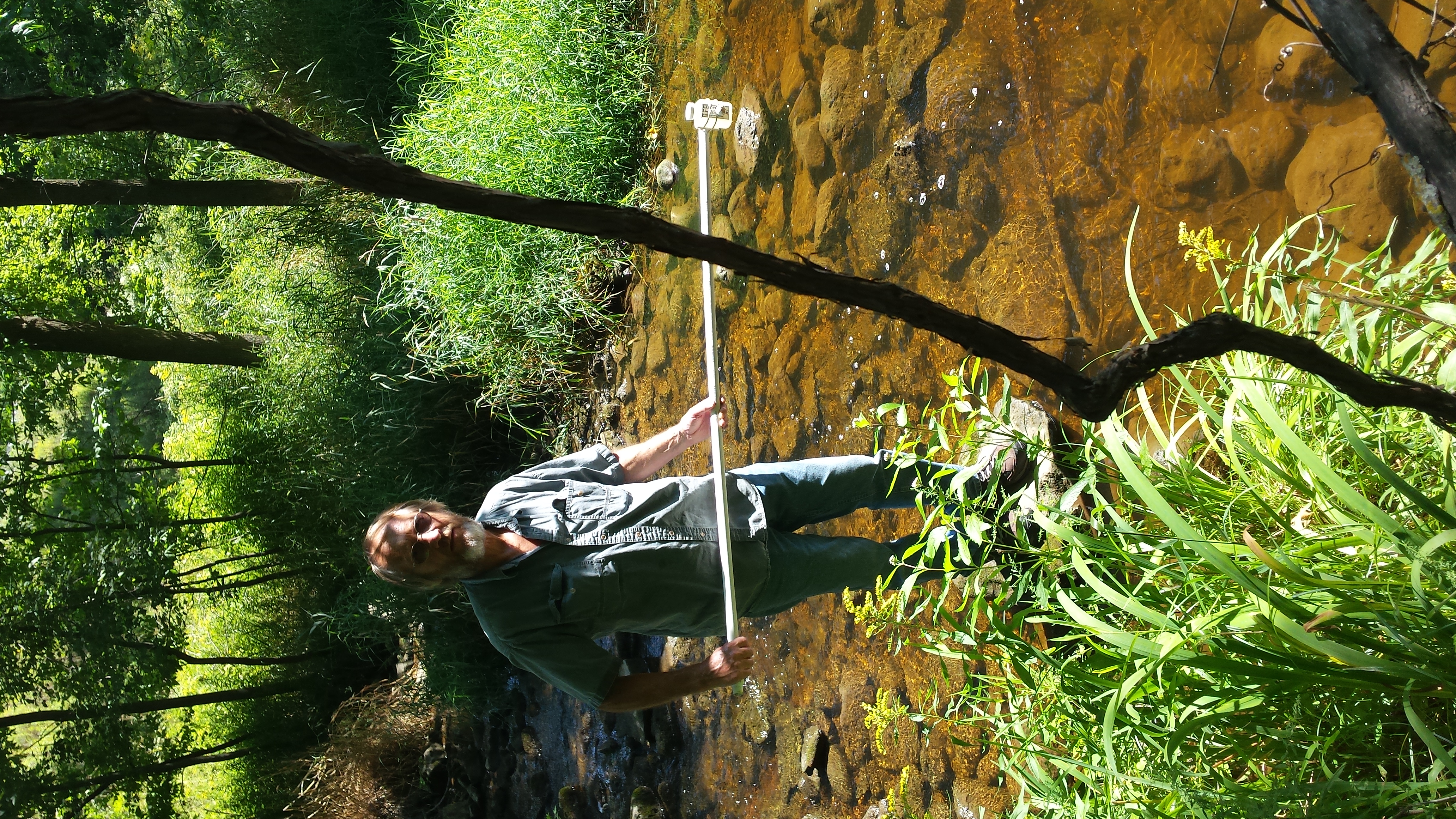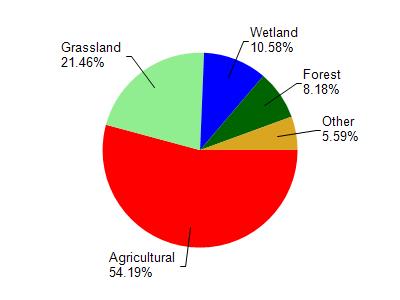
9.49 Miles
0 - 9.49
Cool-Cold Headwater, Cool-Warm Headwater
2019
Poor
Impairment Unknown
Total Phosphorus
Kewaunee, Manitowoc
No
No
Yes
Fish and Aquatic Life
Overview
Black Creek is a 10-mile long tributary of the West Twin River (WCD 1966). Upper sections of the river can be intermittent during dry years, but can carry large amounts of sediment during storm events due to poor agricultural land use practices in the area. The lower section of the river has a moderate gradient of 13.5 feet per mile and habitat ranking of fair. This section has limited fisheries potential because of habitat degradation due to heavy deposits of sediment in the streambed (Bougie and Cleereman 1996).
The lower section of Black Creek is fully meeting its attainable use. The upper section below CTH BB is "partially" supporting, but not impaired. This upper section has been studied by USGS under their long-term monitoring network. WDNR would like to analyze this data to determine condition and look at trends.
Date 2010
Author Mary Gansberg
Historical Description
A large manure spill in 1987 caused heavy fish mortality in the lower 3 miles of the river. The fish that were observed dead during the investigation of this spill included 15,433 minnows, 2,573 suckers and redhorse, 1,700 stonecat and madtom, 300 rock bass, 19 smallmouth bass and 17 northern pike (Peeters 1987). A 2002 survey found a fish community that was dominated by forage fish including blacknose dace, southern redbelly dace, stoneroller and creek chub. The IBI ranking for the section of river surveyed was very good.
Date 2011
Author Aquatic Biologist
Impaired Waters
The 2018 assessments of Black Creek (also know as Buck Creek, WBIC 88300) showed impairment by phosphorus; new total phosphorus sample data exceeded the 2018 WisCALM listing criteria for the Fish and Aquatic Life use. Biological data were not available (i.e. no macroinvertebrate or fish Index of Biotic Integrity (IBI) scores) to assess biological impairment. Based on the most updated information, this water was proposed for the impaired waters list.
Date 2017
Author Ashley Beranek
Condition
Wisconsin has over 84,000 miles of streams, 15,000 lakes and milllions of acres of wetlands. Assessing the condition of this vast amount of water is challenging. The state's water monitoring program uses a media-based, cross-program approach to analyze water condition. An updated monitoring strategy (2015-2020) is now available. Compliance with Clean Water Act fishable, swimmable standards are located in the Executive Summary of Water Condition in 2018. See also the 'monitoring and projects' tab.
Reports
Recommendations
Monitor Fish Community
Monitoring to evaluate aquatic life condition in Black Creek should be conducted when possible. USGS has a long-term monitoring station on this stream. WDNR would like to obtain this data and analyze for condition/ trend summarization (use warmwater IBI).
Management Goals
Wisconsin's Water Quality Standards provide qualitative and quantitative goals for waters that are protective of Fishable, Swimmable conditions [Learn more]. Waters that do not meet water quality standards are considered impaired and restoration actions are planned and carried out until the water is once again fishable and swimmable
Management goals can include creation or implementation of a Total Maximum Daily Load analysis, a Nine Key Element Plan, or other restoration work, education and outreach and more. If specific recommendations exist for this water, they will be displayed below online.
Monitoring
Monitoring the condition of a river, stream, or lake includes gathering physical, chemical, biological, and habitat data. Comprehensive studies often gather all these parameters in great detail, while lighter assessment events will involve sampling physical, chemical and biological data such as macroinvertebrates. Aquatic macroinvertebrates and fish communities integrate watershed or catchment condition, providing great insight into overall ecosystem health. Chemical and habitat parameters tell researchers more about human induced problems including contaminated runoff, point source dischargers, or habitat issues that foster or limit the potential of aquatic communities to thrive in a given area. Wisconsin's Water Monitoring Strategy was recenty updated.
Grants and Management Projects
| Project Name (Click for Details) | Year Started |
|---|
|
|
Monitoring Projects
| WBIC | Official Waterbody Name | Station ID | Station Name | Earliest Fieldwork Date | Latest Fieldwork Date | View Station | View Data |
|---|
| 88300 | Black Creek | 10009862 | Black Creek - Black Creek at County Hwy Bb | 10/22/2002 | 10/22/2002 | Map | Data |
| 88300 | Black Creek | 10038179 | BLACK CREEK AT CURRAN ROAD NEAR DENMARK WI | 6/29/2007 | 6/29/2007 | Map | Data |
| 88300 | Black Creek | 10039159 | Black Creek at Hwy J | 10/17/2019 | 10/17/2019 | Map | Data |
| 88300 | Black Creek | 363268 | Black Creek - Hwy Bb | 3/30/1994 | 11/7/2019 | Map | Data |
|

Watershed Characteristics
Black Creek is located in the West Twin River watershed which is 180.11 mi². Land use in the watershed is primarily agricultural (54.30%), grassland (21.50%) and a mix of wetland (10.60%) and other uses (13.80%). This watershed has 360.91 stream miles, 1,898.59 lake acres and 10,189.53 wetland acres.
Nonpoint Source Characteristics
This watershed is ranked High for runoff impacts on streams, Medium for runoff impacts on lakes and High for runoff impacts on groundwater and therefore has an overall rank of High. This value can be used in ranking the watershed or individual waterbodies for grant funding under state and county programs.However, all waters are affected by diffuse pollutant sources regardless of initial water quality. Applications for specific runoff projects under state or county grant programs may be pursued. For more information, go to surface water program grants.
Black Cr (Buck Creek) is considered a Cool-Cold Headwater, Cool-Warm Headwater under the state's Natural Community Determinations.
Natural communities (stream and lake natural communities) represent model results and DNR staff valiation processes that confirm or update predicted conditions based on flow and temperature modeling from historic and current landscape features and related variables. Predicated flow and temperatures for waters are associated predicated fish assemblages (communities). Biologists evaluate the model results against current survey data to determine if the modeled results are corect and whether biological indicators show water quaity degradation. This analysis is a core component of the state's resource management framework. Wisconsin's Riverine Natural Communities.
Cool (Warm-Transition) Headwaters are small, sometimes intermittent streams with cool to warm summer temperatures. Coldwater fishes are uncommon to absent, transitional fishes are abundant to common, and warm water fishes are common to uncommon. Headwater species are abundant to common, mainstem species are common to absent, and river species are absent.
Cool (Cold-Transition) Headwaters are small, usually perennial streams with cold to cool summer temperatures. Coldwater fishes are common to uncommon (<10 per 100 m), transitional fishes are abundant to common, and warm water fishes are uncommon to absent. Headwater species are abundant to common, mainstem species are common to absent, and river species are absent.